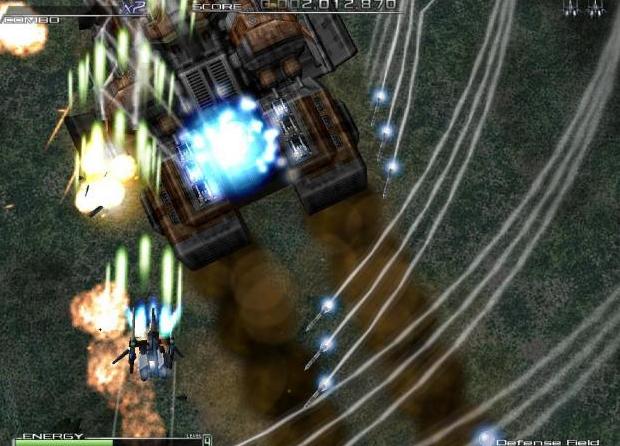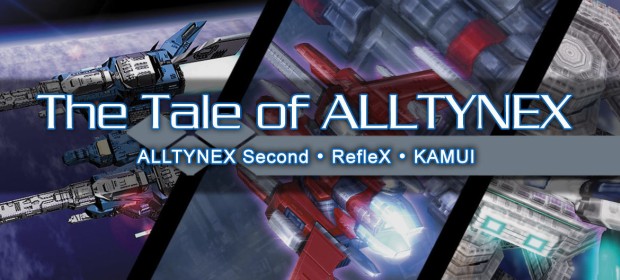Shoot-em-ups, or Shmups, have long been wildly popular in Japan without ever really taking off in the same way in the West. Indeed, Japanese indie development – or Doujin software – is a hotbed for fan-made adaptations of previous Shmups, as well as entirely new titles. One such Doujin developer is Siter Skain, a small group of friends who met at university and started making the type of games they wanted to play. This has resulted in the ALLTYNEX trilogy, a series of Shmups that has gained a cult following in Japan and worldwide.
Only now are the games seeing their release in the West however, thanks to a successful Kickstarter campaign and translation effort. The second game in the trilogy – originally released back in 2008 – is entitled Reflex. The action takes place in a future where a militarised Government clashes with the Valkyness resistance group, who oppose their war-hungry leaders. Their cause seems lost before one of their Scientists develops a new energy core for their ships: the Shield Shot System (S.S.S), which powers a new Phoenix Mk.2 fighter ship – their last hope to defeat the Government. The story is fairly unimportant however, and literally flashes by before you have a chance to take it in – this game focuses purely on the action.

The entire series consists of traditional top-down, two-dimensional shooting action, yet with a few added features that make the gameplay a little deeper and unique. Whilst the Phoenix is equipped with a spread shot cannon – which deteriorates and becomes less effective the more your shields are reduced – it is the shield dynamic that sits at the core of the game. Enemy fire can be deflected or absorbed by the shield – but you only have a limited energy meter for your shields, so must deploy them wisely.
The energy regenerates when not in use, allowing your guns to re-power and you to deflect shots again, but while this is charging you are defenceless against the hordes of enemies. Absorbing certain types of energy fire will recharge it quicker, but you must be careful as some missiles cannot be stopped by any shield. In the tradition of Shmups being unrelentingly difficult, Reflex only gives you six hits before it is game over – with no opportunities at any point to earn extra lives. There are continues to be used – with more gained to use on subsequent play-throughs after you complete a level – but these too are limited and will cause your scores to re-set if used.
So it is the reflexes of the player that are called into play, as knowing exactly when to deploy and drop your shield becomes a constant balance. If it is used correctly, you can turn the weapons of your enemy against them to great effect – but used incorrectly, your energy bars won’t last long. With eight stages to play through, each with a Zodiac-themed mid-level and end of level boss, this won’t be an easy task, and there are no checkpoints and you cannot save your progress. Reflex is firmly old-school in regard to its gameplay structure.

The graphics don’t exactly stand out as amazing upon first glance, but the pixel-based ships and occasional three-dimensional background elements work perfectly well for the genre. Shmups have been prettier – such as recent PS4 launch title Resogun – but the simplistic gameplay is often lost on the move to fully-3D levels or modelling. Reflex’s visuals are probably equal to a PlayStation One game, but neither its graphics nor soundtrack are trying to revolutionise the genre. This is a case of function being more important than form – and in video gaming, shouldn’t that be the case more often than not?
VERDICT: Shmups are certainly an acquired taste, and those who aren’t fans of the genre will probably take one look at Reflex and wonder why a game released in 2014 looks and sounds little better than a Super Nintendo title. It is no more user-friendly either, but gamers who relish a difficult title, and are willing to put in the time needed to master the Shield Shot System, will find a challenging and rewarding shooter here. There is nothing to offer in terms of longevity after the eight levels have been completed, but as this is a download title, you get a fair amount of retro-style carnage for your cash.

GOOD. A game that scores 7/10 is worthy of note, but unworthy of fanfare. It does many things well, but only a few of them incredibly well and, despite a handful of good qualities, fresh ideas and solid mechanics, it fails to overwhelm.
Review code provided by publisher.






